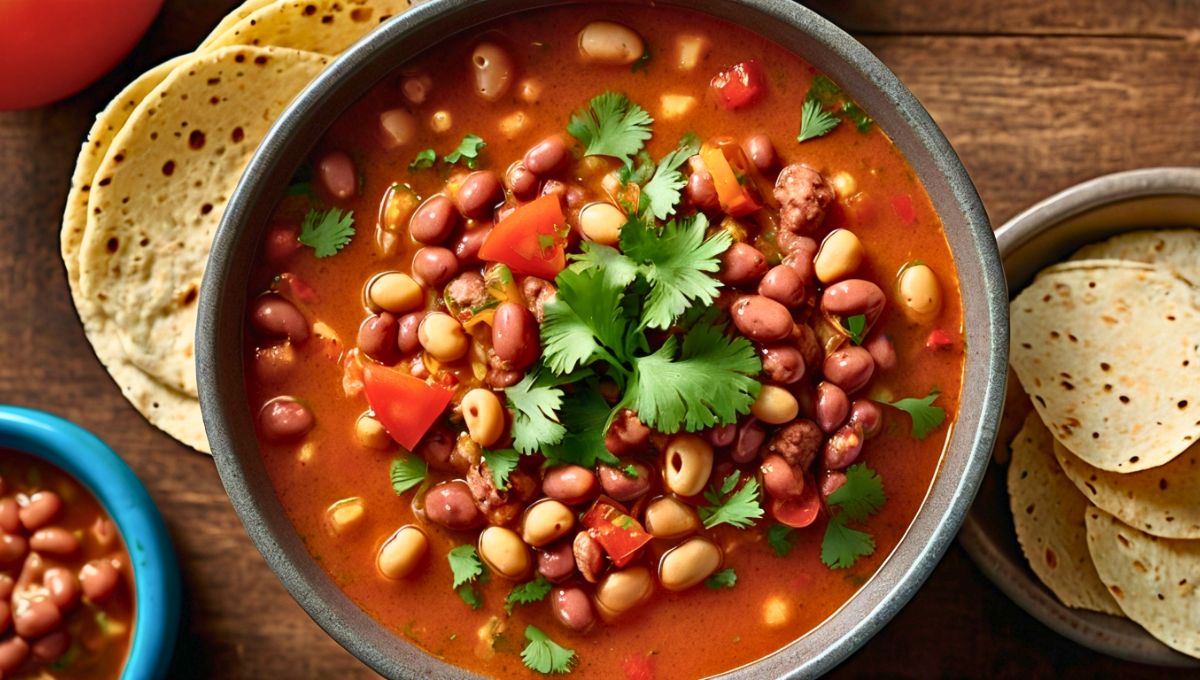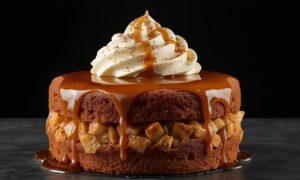Growing up in northern Mexico, the scent of charro beans simmering would fill our entire neighborhood on Sunday mornings. My abuela insisted that the secret wasn’t just in the ingredients; it was in the patience. “Los frijoles charros necesitan tiempo para contar sus historias,” she’d say, meaning the beans needed time to tell their stories. Years later, as a professional chef, I realized how right she was. These humble beans carry centuries of Mexican cowboy culture in every spoonful.
Ever tasted a pot of beans so flavorful, it stole the spotlight from the main dish? That’s the magic of Charro Beans a hearty, smoky, and boldly seasoned side dish straight from Mexican tradition. As a professional cook, I can tell you: when done right, charro beans are more than just beans. They’re comfort food, crowd pleaser, and flavor bomb all in one.
The beauty of these beans lies in their humble simplicity transformed through technique. Traditional Homemade charro beans maintain their integrity in a flavorful broth enriched with crispy bacon, aromatic chiles, and bright herbs. Each spoonful delivers tender beans, salty pork bits, tangy tomatoes, and that remarkable broth that deserves respect (and definitely some warm tortillas for dipping). More than food, they’re a cultural heritage in a bowl, the everyday luxury of Mexican ranch cuisine.
The History Behind the Pot
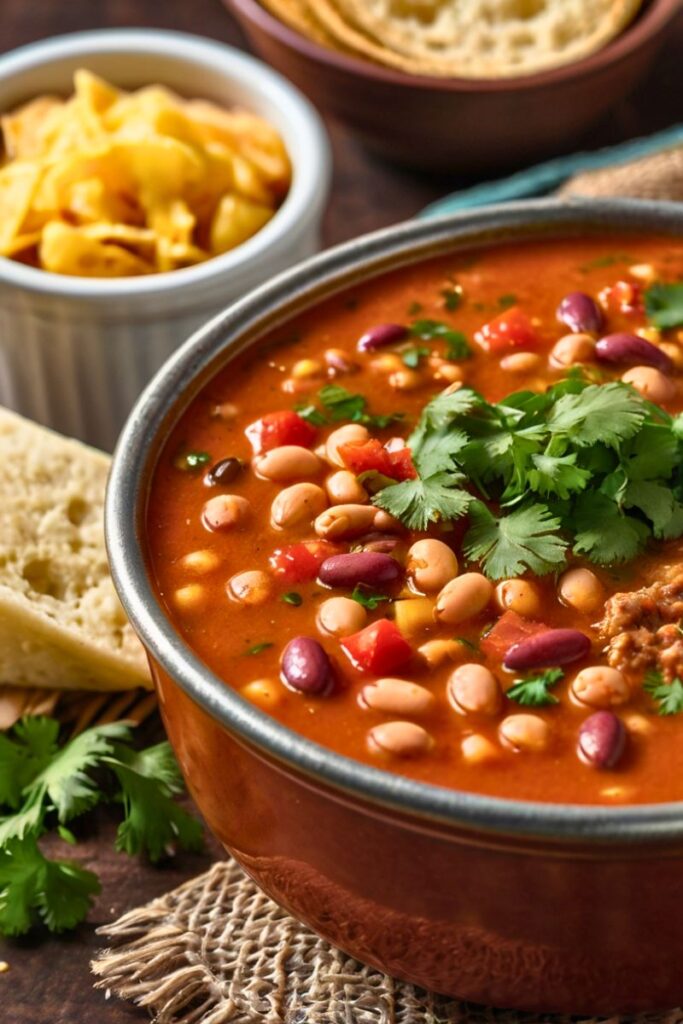
Charro beans emerged from the northern regions of Mexico, particularly Jalisco and Michoacán, where horseback riding cowboys needed filling, portable meals. The original versions were cooked in cast iron pots hung over campfires, allowing flavors to develop slowly throughout the day.
The name “charro” refers directly to these Mexican cowboys, who wore distinctive outfits with elaborate embroidery and wide brimmed sombreros. Their culinary traditions were born from necessity using ingredients that traveled well and creating dishes that could feed many hungry workers with minimal fuss.
Interestingly, charro beans aren’t just delicious, they’re practical. The combination of beans and pork provides complete protein, while the brothy nature makes them hydrating in hot climates. This wasn’t just convenient cooking; it was survival cuisine disguised as comfort food.
Ingredients & Substitutions
For Traditional Charro Beans:
- 1 pound (454g) dried pinto beans, sorted and rinsed
- 8 ounces (226g) thick cut bacon, diced
- 1 medium white onion, finely diced
- 4-5 garlic cloves, minced
- 2-3 serrano peppers, minced (seeds removed for less heat)
- 1 large tomato, diced (about 1 cup)
- 1 bunch fresh cilantro, chopped (reserve some for garnish)
- 2 teaspoons ground cumin
- 1 teaspoon dried oregano (Mexican oregano preferred)
- 2 bay leaves
- 8 cups chicken broth or water
- Salt to taste
- 1 lime, cut into wedges, for serving
When selecting pinto beans, look for beans that are uniform in color without wrinkles or damages. Freshly dried beans (yes, that sounds contradictory!) cook more evenly and develop better texture than those that have been sitting in storage for years. If pintos aren’t available, you can substitute black beans or Peruvian beans, though the flavor profile will shift slightly.
For vegetarian versions, omit the bacon and use smoked paprika (1 tablespoon) and vegetable broth enhanced with a few drops of liquid smoke. The smokiness is essential to the authentic charro experience. Some modern interpretations add chorizo or ham, which work beautifully if bacon isn’t your thing.
Fresh serrano peppers offer the most authentic flavor, but jalapeños make a perfectly acceptable substitution. For those sensitive to heat, poblano peppers provide the Chile flavor without overwhelming spiciness. In a real pinch, canned green chiles work too, just drain them well.
Step by Step Instructions
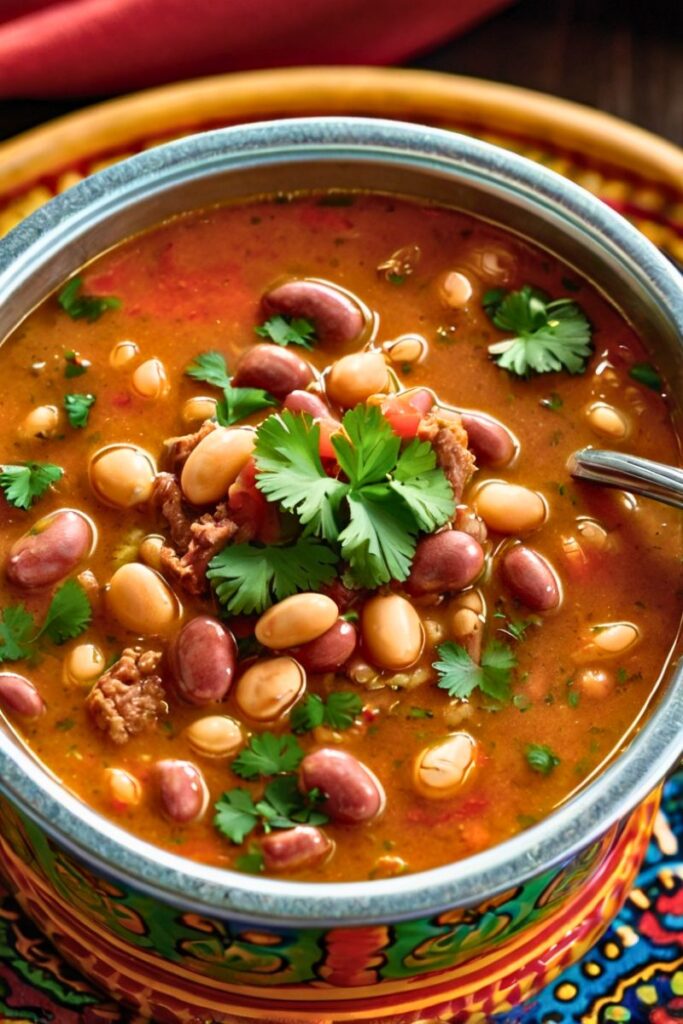
Preparing the Beans
- The Soak Decision: Traditionally, charro beans aren’t pre soaked, but soaking overnight reduces cooking time by about 30-45 minutes and can make beans more digestible. If time permits, cover beans with cold water and let stand overnight. If not, proceed with the “quick soak” method: cover with water, bring to boil for 2 minutes, remove from heat, cover and let stand for 1 hour.
- Prepare Your Mise en Place: While beans are soaking (or before starting if not soaking), dice all vegetables and measure spices. This organization makes the cooking process much smoother. A common mistake is not having ingredients ready when needed, which can result in overcooked bacon or burned garlic.
- Drain and Rinse: Whether soaked overnight or quick soaked, drain beans and rinse thoroughly under cold water. This removes excess starch that can cause foaming during cooking.
Cooking the Base
- Build Your Flavor Foundation: In a large, heavy bottomed pot (cast iron Dutch ovens work beautifully), cook diced bacon over medium heat until fat renders and bacon is crisp, about 8-10 minutes. Don’t rush this step, properly rendered bacon fat is liquid gold for flavoring the beans.
- Soften the Aromatics: Add diced onion to the bacon and fat, cooking until translucent but not browned, about 5 minutes. Then add garlic and serrano peppers, cooking for just 1 minute until fragrant. Watch carefully here; garlic burns easily and becomes bitter.
- Bloom the Spices: Add cumin and oregano directly to the fat in the pot and stir continuously for 30 seconds. This technique, called “blooming,” releases essential oils in the spices and significantly enhances their flavor. You’ll know it’s working when the aromatic compounds hit your nose!
Bringing It All Together
- Add Beans and Liquid: Add the drained beans to the pot along with bay leaves and chicken broth (or water). If using water, you may want to add a chicken bouillon cube for depth of flavor. Bring to a boil, then reduce to a gentle simmer.
- The Patience Stage: Cover partially and simmer for approximately 1.5-2.5 hours, depending on the age of your beans and whether they were soaked. Test occasionally by sampling a bean it should be tender throughout with no chalky center, but not mushy. The cooking time varies wildly depending on your specific beans, so start testing after an hour.
- Final Flavor Additions: When beans are nearly tender, add diced tomato and half the cilantro. Continue cooking for 15-20 more minutes to meld flavors. Season with salt only at this final stage, adding salt too early can toughen bean skins. I usually start with 1 teaspoon and adjust from there.
Variations to Consider
- Chorizo Charro Beans: Replace half the bacon with Mexican chorizo for a spicier, more complex flavor.
- Beer Simmered Beans: Substitute 12 ounces of Mexican lager for equal amount of broth for a subtle malty depth.
- Vegetarian Option: Use smoked paprika, chipotle peppers in adobo, and vegetable broth instead of bacon and chicken broth.
For a thicker consistency, mash about a quarter of the beans against the side of the pot with a wooden spoon during the final 30 minutes of cooking. This naturally thickens the broth without need for additives.
Cooking Techniques & Science
Understanding the science behind charro beans helps perfect the dish. Beans contain proteins and starches that require slow, gentle heat to break down properly. Rapid boiling causes bean skins to burst before the centers cook, resulting in an unevenly textured dish.
The reason we don’t add salt until the end relates directly to bean physiology. Salt competes with calcium and magnesium to pass through the semi permeable membrane of the bean skin. When introduced early, it can prevent water absorption, resulting in beans that never fully soften. This isn’t just old wives tale cooking it’s food science.
The layering of flavors in charro beans follows classical culinary technique. We start with rendering fat from bacon, creating a flavorful base that’s both lipid soluble (carrying fat soluble flavor compounds) and water soluble (enhancing the broth). This technique, similar to making a proper French mirepoix or Italian soffritto, ensures depth of flavor impossible to achieve by simply throwing everything together.
Another important consideration is the cooking vessel. Traditional clay pots (ollas de barro) impart a mineral quality to the beans that metal pots can’t replicate. However, heavy enameled cast iron provides excellent heat distribution and retention, making it the next best option for most home cooks. Avoid aluminum pots, which can react with acidic ingredients like tomatoes.
The simmering process allows beans to slowly release their starches, naturally thickening the broth. Pay attention to the surface of your simmering beans you want gentle bubbles, not a rolling boil. Some abuelitas insist that beans should only be stirred clockwise to prevent the evil eye, but scientifically speaking, minimal stirring prevents breakage regardless of direction.
Serving & Pairing Suggestions
Charro beans are traditionally served in small, deep bowls that showcase the rich broth. Garnish with remaining fresh cilantro, a squeeze of lime juice, and perhaps a few thin slices of radish for color and crisp texture contrast. In some regions, crumbled queso fresco or cotija cheese is added just before serving.
For authentic presentation, offer warm corn tortillas on the side. The proper technique involves tearing a piece of tortilla, folding it to create a small scoop, and using it to capture beans and broth together. This beats spoons for true flavor appreciation, tho it does require some practice to prevent drips!
Charro beans complement nearly any Mexican main dish but pair particularly well with:
- Carne asada or grilled meats
- Enchiladas (especially cheese or chicken)
- Simple grilled fish with minimal seasoning
- Chilaquiles for an incredible breakfast or brunch
Don’t limit charro beans to side dish status! They make an exceptional main course when served with rice, avocado slices, and pickled red onions. In northern Mexico, they’re often enjoyed as a hearty breakfast, sometimes with a fried egg on top.
For beverages, the natural pairing is Mexican beer specifically a Vienna style lager like Negra Modelo or Dos Equis Ambar. The malty sweetness balances the savory, spicy beans beautifully. Non alcoholic options include agua fresca de jamaica (hibiscus tea) or horchata for cooling contrast.
Storage and Reheating
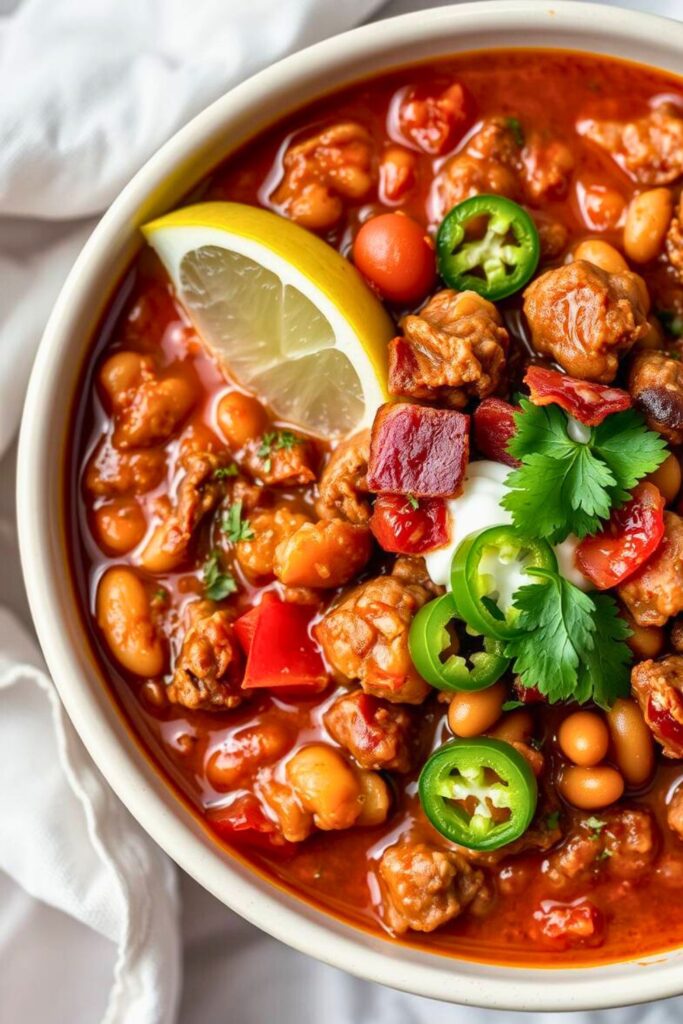
Like many bean dishes, charro beans actually improve with time as flavors meld. They’ll keep in the refrigerator for 4-5 days in an airtight container. When reheating, add a splash of water or broth as the beans will have absorbed liquid during storage.
For freezing, cool completely before transferring to freezer safe containers, leaving about an inch of headspace for expansion. Frozen charro beans maintain quality for about 3 months. Thaw overnight in the refrigerator before reheating gently on the stovetop.
Bringing It All Together – Charro Beans Recap
Charro beans embody the heart and soul of Mexican cowboy cuisine simple ingredients transformed through time and technique into something extraordinary. The secret? Patience. These beans demand slow cooking to develop their complex flavor profile, rewarding you with layers of smokiness, spice, earthiness, and freshness in perfect harmony.
Most home cooks rush the process, but great charro beans can’t be hurried. They teach us that simplicity, when respected, yields incredible depth. Whether served alongside grilled meats at a backyard gathering or enjoyed alone with fresh tortillas, they connect us to generations of tradition.
As my abuela wisely said, “Un buen plato de frijoles charros puede arreglar cualquier problem” a good bowl of charro beans can fix any problem. After years in professional kitchens, I’ve found no reason to disagree.
Charro Beans Cooking Q&A
Can I make charro beans in a slow cooker or pressure cooker?
Yes! For slow cookers: sauté bacon and aromatics first, then transfer everything to the slow cooker (low: 6-8 hours, high: 4-5 hours). For pressure cookers: reduce liquid by 25%, sauté ingredients first, then cook at high pressure (40 minutes for soaked beans, 55 for unsoaked) with natural release.
Why are my beans still hard after cooking?
Common culprits: old beans, hard water (try bottled), high altitude, or adding acidic ingredients too early. Always add tomatoes and lime after beans have softened to prevent toughening. Even salt added too early can slow softening, so season after the simmer for best texture.
Can I use canned beans as a shortcut?
Yes rinse well, add after cooking bacon and aromatics, and simmer just 30 minutes. You’ll miss some thickness in the broth, but the flavor will still be good.
How spicy should authentic charro beans be?
Traditionally moderate noticeable but not overwhelming. Adjust heat by changing the amount of peppers or removing seeds and membranes. Some regions use chipotle in adobo for smoky heat.

Swiftly Captions by Tina Smith — Quick, flavorful food recipes made simple, bringing fresh inspiration to your kitchen every day
